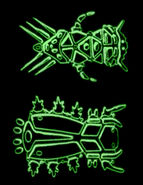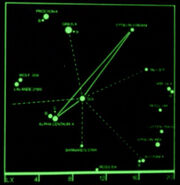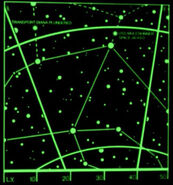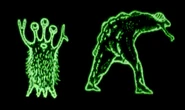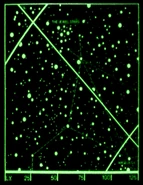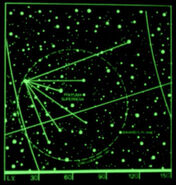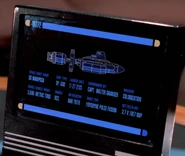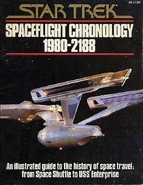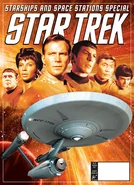m (→Production use) |
m (fm) |
||
| (3 intermediate revisions by 2 users not shown) | |||
| Line 9: | Line 9: | ||
| ISBN = 0671790897 (both editions) |
| ISBN = 0671790897 (both editions) |
||
}} |
}} |
||
| − | The '''''Star Trek Spaceflight Chronology''''' is a [[reference book]] which catalogs mankind's technological endeavors into space, spanning the period from the launch of the first artificial satellite, ''[[Sputnik I]]'', to the events depicted in {{film|1}}, and the technology developed along the way. As such, it is a mixture of real-world events up until the [[space shuttle orbiter]] in 1980, and conjectural events afterwards, some of which were depicted or referenced during the run of {{s| |
+ | The '''''Star Trek Spaceflight Chronology''''' is a [[reference book]] which catalogs mankind's technological endeavors into space, spanning the period from the launch of the first artificial satellite, ''[[Sputnik I]]'', to the events depicted in {{film|1}}, and the technology developed along the way. As such, it is a mixture of real-world events up until the [[space shuttle orbiter]] in 1980, and conjectural events afterwards, some of which were depicted or referenced during the run of {{s|TOS}}. |
==Summary== |
==Summary== |
||
| Line 35: | Line 35: | ||
*The book was one of a total of sixteen titles, both [[novels]] and reference books, that were intended to coincide as a promotional tie-in with the premiere of ''The Motion Picture'' on 7 December 1979. (''Playboy'' magazine, January 1980, p. 310) However, due to the film's mixed reception, only about half of these, including this one, were ultimately released. |
*The book was one of a total of sixteen titles, both [[novels]] and reference books, that were intended to coincide as a promotional tie-in with the premiere of ''The Motion Picture'' on 7 December 1979. (''Playboy'' magazine, January 1980, p. 310) However, due to the film's mixed reception, only about half of these, including this one, were ultimately released. |
||
*An abridged UK edition, entitled ''Star Trek Spaceflight Chronology 1980-2188'' was published the same year by publishing house [[Phoebus]]. |
*An abridged UK edition, entitled ''Star Trek Spaceflight Chronology 1980-2188'' was published the same year by publishing house [[Phoebus]]. |
||
| − | *At the time this book was published, ''The Spaceflight Chronology'' was the second officially licensed reference book, intended for publication to the general public, that delved into the history of the ''Star Trek'' universe from an in-universe perspective, the first one being ''[[Star Trek Star Fleet Technical Manual]]''. This was also the first Star Trek chronology. As it often happens, the exact dating and several details of many events in the timeline have become outdated by new [[canon]] information introduced in subsequent ''Star Trek'' productions, starting with {{s| |
+ | *At the time this book was published, ''The Spaceflight Chronology'' was the second officially licensed reference book, intended for publication to the general public, that delved into the history of the ''Star Trek'' universe from an in-universe perspective, the first one being ''[[Star Trek Star Fleet Technical Manual]]''. This was also the first Star Trek chronology. As it often happens, the exact dating and several details of many events in the timeline have become outdated by new [[canon]] information introduced in subsequent ''Star Trek'' productions, starting with {{s|TNG}}{{'}}s [[TNG Season 1|first season]] in 1987. Yet, as one of only three in-universe sources available at the time (the third one being [[Bjo Trimble]]'s ''[[Star Trek Concordance]]''), it was used as a model for [[FASA]]'s [[Star Trek: The Role Playing Game|role-playing games]] and several [[novels]] of the era. The book was also used on occasion as reference source by ''The Next Generation'' staff in the early stages of the series. |
| − | *In addition to several newly invented starships found only within this volume, the chronology offered specifications, depictions and further development history information for several canonically established vessels such as the original and [[refit]]ted {{class|Constitution}}, the [[Class F shuttlecraft]], the [[DY-100 class]], the [[DY-500 class]], the [[Earth-Saturn probe]], the {{USS|Enterprise|XCV 330| (XCV 330)}}, the {{USS|Horizon}} and the {{USS|Valiant|23rd century}}. Also, other historical information provided during the original run of |
+ | *In addition to several newly invented starships found only within this volume, the chronology offered specifications, depictions and further development history information for several canonically established vessels such as the original and [[refit]]ted {{class|Constitution}}, the [[Class F shuttlecraft]], the [[DY-100 class]], the [[DY-500 class]], the [[Earth-Saturn probe]], the {{USS|Enterprise|XCV 330| (XCV 330)}}, the {{USS|Horizon}} and the {{USS|Valiant|23rd century}}. Also, other historical information provided during the original run of TOS was incorporated into the book. Information from {{s|TAS}} was mostly ignored. The two exceptions were information about the [[Terra 10]] colony ship mentioned in the {{TAS|The Terratin Incident}} and the {{dis|Bonaventure|10281NCC}} from {{TAS|The Time Trap}}. The depiction of the ''Bonaventure'' from the animated series however was utterly disregarded and a brand-new, more "archaic" looking design was introduced instead. |
*In 2011, authors [[Dayton Ward]] and [[Kevin Dilmore]] paid homage to ''The Spaceflight Chronology'' as they attempted to update the ''Chronology'' with insight garnered since its publications. They wrote a ten-page article that consisted of sections written in the style of ''The Spaceflight Chronology'' which incorporated updated material, canonically established in the ''Star Trek'' franchise since then. Their homage has been published in {{STM|162}}, pages 62-73. |
*In 2011, authors [[Dayton Ward]] and [[Kevin Dilmore]] paid homage to ''The Spaceflight Chronology'' as they attempted to update the ''Chronology'' with insight garnered since its publications. They wrote a ten-page article that consisted of sections written in the style of ''The Spaceflight Chronology'' which incorporated updated material, canonically established in the ''Star Trek'' franchise since then. Their homage has been published in {{STM|162}}, pages 62-73. |
||
| − | * Like the ''Technical Manual'', the book has lost its official status when the |
+ | * Like the ''Technical Manual'', the book has lost its "official" – as in compliance with [[canon]] – status when the ''Star Trek'' [[franchise]] formally demoted the book to apocrypha status in 2002. ({{STTM|2|11|71}}) |
===Production use=== |
===Production use=== |
||
Revision as of 15:33, 27 September 2019
(written from a Production point of view)
The Star Trek Spaceflight Chronology is a reference book which catalogs mankind's technological endeavors into space, spanning the period from the launch of the first artificial satellite, Sputnik I, to the events depicted in Star Trek: The Motion Picture, and the technology developed along the way. As such, it is a mixture of real-world events up until the space shuttle orbiter in 1980, and conjectural events afterwards, some of which were depicted or referenced during the run of Star Trek: The Original Series.
Summary
- From the book jacket (US)
- The stars beckon… man responds! The Human adventure is just beginning!
- The publication of this book initiates an exciting and necessary project: to provide Star Fleet Academy Cadets with a concise illustrated history of their home planets, spaceflight, evolution and development.
- So, Cadets from Earth, welcome to the history of your planet's two and a half illustrious centuries in space – years filled with extraordinary achievement, darkened by great tragedy, marked by countless marvels and perils. The future will be made by you who read this chronology.
- Learn the past to make the future.
- Live long and prosper!
- From the book jacket (UK)
- The Spaceflight Chronology – abridged from a much greater work – has been compiled to provide Star Fleet Academy Cadets with a concise, illustrated history of their home planet's spaceflight evolution and technical development. It covers two centuries, starting with the first Space Shuttle flights in 1980 and ending with the heavy cruiser Constitution class star ships in 2188. More than 100 spacecrafts are featured; these include the Icarus which, in 2048, made Earth's first contact with the Alpha Centauri civilization and the King Charles, the most luxurious starliner ever built.
- Henceforth, freshman Cadets of planet Earth and eventually freshman Cadets from Vulcan, Rigel, Alpha Centauri, Tellar and Andor, should include Spaceflight Chronology on their essential reading list.
- UNITED FEDERATION OF PLANETS
- Excerpts of copyrighted sources are included for review purposes only, without any intention of infringement.
Background information
- The book was one of a total of sixteen titles, both novels and reference books, that were intended to coincide as a promotional tie-in with the premiere of The Motion Picture on 7 December 1979. (Playboy magazine, January 1980, p. 310) However, due to the film's mixed reception, only about half of these, including this one, were ultimately released.
- An abridged UK edition, entitled Star Trek Spaceflight Chronology 1980-2188 was published the same year by publishing house Phoebus.
- At the time this book was published, The Spaceflight Chronology was the second officially licensed reference book, intended for publication to the general public, that delved into the history of the Star Trek universe from an in-universe perspective, the first one being Star Trek Star Fleet Technical Manual. This was also the first Star Trek chronology. As it often happens, the exact dating and several details of many events in the timeline have become outdated by new canon information introduced in subsequent Star Trek productions, starting with Star Trek: The Next Generation's first season in 1987. Yet, as one of only three in-universe sources available at the time (the third one being Bjo Trimble's Star Trek Concordance), it was used as a model for FASA's role-playing games and several novels of the era. The book was also used on occasion as reference source by The Next Generation staff in the early stages of the series.
- In addition to several newly invented starships found only within this volume, the chronology offered specifications, depictions and further development history information for several canonically established vessels such as the original and refitted Constitution-class, the Class F shuttlecraft, the DY-100 class, the DY-500 class, the Earth-Saturn probe, the USS Enterprise (XCV 330), the USS Horizon and the USS Valiant. Also, other historical information provided during the original run of TOS was incorporated into the book. Information from Star Trek: The Animated Series was mostly ignored. The two exceptions were information about the Terra 10 colony ship mentioned in the TAS: "The Terratin Incident" and the Bonaventure from TAS: "The Time Trap". The depiction of the Bonaventure from the animated series however was utterly disregarded and a brand-new, more "archaic" looking design was introduced instead.
- In 2011, authors Dayton Ward and Kevin Dilmore paid homage to The Spaceflight Chronology as they attempted to update the Chronology with insight garnered since its publications. They wrote a ten-page article that consisted of sections written in the style of The Spaceflight Chronology which incorporated updated material, canonically established in the Star Trek franchise since then. Their homage has been published in Star Trek Magazine issue 162, pages 62-73.
- Like the Technical Manual, the book has lost its "official" – as in compliance with canon – status when the Star Trek franchise formally demoted the book to apocrypha status in 2002. (Star Trek: The Magazine Volume 2, Issue 11, p. 71)
Production use
Several graphics from the reference book were used in canon productions. Starcharts, depictions of alien lifeforms and starship designs appeared in The Next Generation as computer readouts in such episodes as TNG: "The Naked Now", "The Last Outpost", "Datalore", "Conspiracy". [1] These transparacies were created at Michael Okuda's art department, who was a close co-worker and friend of the book's illustrator, Rick Sternbach, who himself worked on the series as production illustrator.
Another depiction that influenced canon was the depiction of an uprated 21st century DY-500 class sublight ship on page 37. In the second season episode TNG: "Up The Long Ladder", the depiction of a canonical 22nd century DY-500 class starship was heavily influenced by this original design, introduced in The Spaceflight Chronology.
This imagery at least is considered canon, and as such valid background information, by Memory Alpha.
Cover gallery
External link
- Star Trek Spaceflight Chronology at Memory Beta, the wiki for licensed Star Trek works

